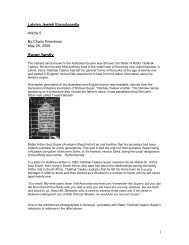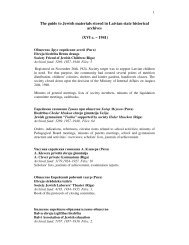Small Riga Ghetto
Small Riga Ghetto
Small Riga Ghetto
Create successful ePaper yourself
Turn your PDF publications into a flip-book with our unique Google optimized e-Paper software.
253<br />
Later we found out the reason: the whole work crew had been taken back to<br />
the camp that night. Understandably, the women were thrown into a huge<br />
panic. All the women in the barracks also had to come out. All of them were<br />
ordered to line up around a square, in the middle of which stood a gallows.<br />
Not long afterward, a closed car drove up. Out of it stepped the executioner,<br />
wearing a top hat, patent-leather shoes and white gloves. The SS girls brought<br />
out a Ukrainian girl who was already half-dead. The main overseer held a<br />
short lecture. She declared that this girl had been condemned to die because of<br />
sabotage. The same thing would happen to any of them if they took even the<br />
slightest liberty. Then the poor woman was killed very quickly. Afterwards,<br />
all of them without exception had to march past the corpse. Anyone who didn't<br />
was beaten. People said the "sabotage" had taken place as follows: one of the<br />
factory foremen had tried to molest her and she had slapped his face in public.<br />
People also said that after the liberation this foreman had immediately been<br />
arrested by the Jews. His subsequent fate is unknown.<br />
VI.<br />
At the beginning of 1945 the factory was no longer operating at full capacity.<br />
The scarcity of raw materials was having its effect. There were days on which<br />
we only had to work for a few hours. But of course both the management and<br />
the foremen had the greatest interest in keeping the factory in operation. They<br />
knew very well that if the factory closed they would be drafted into the army.<br />
They found a solution by lending some of us Jewish workers to the NSDAP<br />
(National Socialist German Workers' Party). Our new occupation consisted of<br />
hauling material out of the bombed houses that could be used to build fortifications<br />
against the enemy. The factory management had to negotiate with the<br />
NSDAP for a fairly long time about our deployment, as the party officials<br />
were unwilling to send us to work in the town.<br />
We men marched out of the gates of Polte for the first time. Not long after<br />
we had left the camp we could already see the first ruins. Under heavy guard<br />
we marched through the once-beautiful town of Magdeburg. We went through<br />
the center of town, past the main railroad station, and saw not a single house<br />
that was whole, only rubble. Huge apartment buildings had collapsed like<br />
houses of cards. Only a few people were out on the streets. The guards drove<br />
us toward the Hindenburg Bridge, which we had to fortify against the enemy.<br />
There was one thing we could not understand at all: Magdeburg, which lay in<br />
the heart of Germany, had to be protected from the enemy already? "Comrades,"<br />
I called out, "it makes sense, it's all clear to me now!" We have a say-










